|
Mitsubishi Colt
Debut: 2004
Maker: Mitsubishi
Predecessor: no |
|
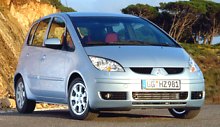 Everybody
knows Mitsubishi is now facing a critical, live-or-die situation.
Losses,
recalls, lost of customer trust and the withdrawal of DaimlerChrysler
could
be factors that kill the long-standing Japanese company. In the end,
only
good products can save it. Colt could be the car. In the financial year
ended on 31 May 2004, Mitsubishi's sales in the North American slide by
a horrible 20%. The reason is every bit predictable: its product
line-up
is uncompetitive. In contrast, domestic sales - supposed to be hit by
bad
reputation due to recalls and criminal charges for hiding faults in
cars
- rose slightly while European sales even jumped by 7%. Furthermore,
Mitsubishi
Europe estimates another rise of 20% next year. All thanks to the new
Colt. Everybody
knows Mitsubishi is now facing a critical, live-or-die situation.
Losses,
recalls, lost of customer trust and the withdrawal of DaimlerChrysler
could
be factors that kill the long-standing Japanese company. In the end,
only
good products can save it. Colt could be the car. In the financial year
ended on 31 May 2004, Mitsubishi's sales in the North American slide by
a horrible 20%. The reason is every bit predictable: its product
line-up
is uncompetitive. In contrast, domestic sales - supposed to be hit by
bad
reputation due to recalls and criminal charges for hiding faults in
cars
- rose slightly while European sales even jumped by 7%. Furthermore,
Mitsubishi
Europe estimates another rise of 20% next year. All thanks to the new
Colt.
Mitsubishi
introduced the 6th generation Colt to the domestic market in Nov 2002
and
then Europe one and a half year later. Why did it take so long to reach
the European shore? because instead of importing from Japan, the
European
Colt was considerably re-engineered to suit the European tastes and was
transferred to Holland for production. It is being produced in the
Nedcar
plant left by Carisma and Volvo S40. The plant is now a 50-50 joint
venture
between Mitsubishi and DamilerChrysler. The latter uses it to produce
Smart
Forfour alongside the Colt. The Smart and the Mitsubishi are actually
sister
cars, sharing as much as 60% components to make the Smart project
financially
viable while increasing the profitability of Colt. However, the Smart
is
designed to be a niche car, selling at premium price to scare its
customers
(as my previous report found out), thus it will sell at a volume no
where
near the Colt. Although Smart insisted its car has equal status with
the
Mitsubishi in the project, it is clear that Mitsubishi was the core. It
developed the whole car including the chassis, engines and
transmissions.
The European (Mercedes) only contributed a couple of diesel engines
because
Mitsubishi does not need them in Japan and it would be more cost
effective
to out source. Smart only joined the project in later stage of the
development.
One
of the reasons why the Colt was so well accepted in Europe is its
European
flavor - it was designed by ex-Mercedes designer Olivier Boulay, who
joined
Mitsubishi as design chief after designing Peugeot 206 and Maybach. No
wonder the Colt looks so much like Mercedes A-class. The sharp styling
encloses a MPV-like profile. It occupies roughly the same parking space
as Honda Fit (Jazz), but it is 2.5cm taller and boosts a 5cm longer
wheelbase.
That make it both the tallest and the longest wheelbase car in the
B-segment.
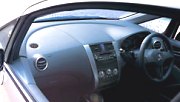 Enter
the cabin, you will find the extra dimensions pay off. It is very roomy
for all passengers, especially rear legroom because the rear seat can
slide
to alter the distribution between passenger and luggage space. All
passengers
sit high as in MPVs but still enjoy vast of headroom. The ambience is
airy
and cheerful, thanks to huge windscreen and big windows. But like many
MPVs, the far forward A-pillars create blind spots. Japanese and
European
versions employ different dashboard design (shown here is the
Japanese
version), the former is more elegant while the latter is more
funky.
However, both are made of soft touch plastics to deliver a quality
feel.
Overall speaking, the cabin is a lovely place to be in. Enter
the cabin, you will find the extra dimensions pay off. It is very roomy
for all passengers, especially rear legroom because the rear seat can
slide
to alter the distribution between passenger and luggage space. All
passengers
sit high as in MPVs but still enjoy vast of headroom. The ambience is
airy
and cheerful, thanks to huge windscreen and big windows. But like many
MPVs, the far forward A-pillars create blind spots. Japanese and
European
versions employ different dashboard design (shown here is the
Japanese
version), the former is more elegant while the latter is more
funky.
However, both are made of soft touch plastics to deliver a quality
feel.
Overall speaking, the cabin is a lovely place to be in.
The
flexibility of rear seat can rival any real MPVs. It can slide forward
to increase luggage space, fold down to form a flat load area, tumble
forward
to store tall things or even completely detach. In case of long things,
the front passenger seat can fold down to increase the maximum length.
Which car can beat it for flexibility?
Large
cabin and high-quality interior usually lead to increased weight. This
is a common trend of mini cars. Most rivals weigh between 1040kg and
1100kg,
but Mitsubishi did a good job to keep Colt under 1 ton, from 965kg to
990kg
depending on engines. This is quite surprising considering its
class-leading
interior space. Part of the contribution is the aluminum head and block
engines with thermoplastic intake manifolds and cam cover.
 All
engines are eager and produce pretty high output for their
displacement,
thanks to Mitsubishi's MIVEC variable intake valve timing and lift.
This
cam-changing VVT technology was used in FTO to produce up to 100
horsepower
per litre. In the bread-and-butter Colt, they are of course optimized
for
economy and flexibility. Nevertheless, the base 1.1-litre 3-cylinder
engine
still produces a respectable 75hp, more than Volkswagen's 1.2-litre
tripe
by 10 horsepower despite of its smaller capacity. A balance shaft is
employed
to cancel vibration, so it revs reasonably smooth. All
engines are eager and produce pretty high output for their
displacement,
thanks to Mitsubishi's MIVEC variable intake valve timing and lift.
This
cam-changing VVT technology was used in FTO to produce up to 100
horsepower
per litre. In the bread-and-butter Colt, they are of course optimized
for
economy and flexibility. Nevertheless, the base 1.1-litre 3-cylinder
engine
still produces a respectable 75hp, more than Volkswagen's 1.2-litre
tripe
by 10 horsepower despite of its smaller capacity. A balance shaft is
employed
to cancel vibration, so it revs reasonably smooth.
At
the other end of the range, the most powerful engine is a 4-cylinder
version
of the triple, sharing the same bore and stroke dimensions. It produces
109hp out of just 1.5 litres, again beating most rivals. But it sounds
coarse at high rev, so the pick of the range falls into the 1332 cc
four-cylinder,
which is the short-stroke version of the 1.5. It is more willing,
smoother
and quieter. 95 horsepower combines with 975kg kerb weight result in a
brisk performance - 60mph is reached in 10.4 seconds only. Mating with
the light and quick-shifting manual gearbox, the Colt is really
enjoyable
to drive.
With
the tallest body in the class, does it handle well? in contrast to
prediction,
it does! well, the softly sprung Japanese version rolls more in corner
than keen drivers would like, but considering its intention as an inner
city transport, that's fully understandable. The European Colt has
stiffer
suspension setup. Ride is a little firm but compensates with
well-judged
damping which resists float and crash. Body roll is surprisingly
minimal.
The Colt goes into corners with real agility and crispness. Its wide
tires
provide generous grip, but it can play lift-off oversteer as well. This
make it more fun to drive than sister car Smart Forfour. Both cars
share
an electrical power steering, but the Mitsubishi's setup provides more
feel, if not really matching conventional hydraulic steering. The
steering
is also quick, precise and well weighted.
Well
done, Mitsubishi. After years of disappointing effort, it has finally
produced
a class winner. The Colt is a very efficient mini car. Its small engine
produces big power. Its light body encloses a big interior. Its cockpit
is comfortable, nice-feeling and highly flexible. Its chassis is well
engineered
to deliver capable handling and ride. Most important, it is fun to
look,
to sit and to drive. This could be the savior to Mitsubishi.
|
| The
above report was last updated on 22 Jul
2004. All Rights Reserved. |
Colt CZT
|
 Europe
is by far the world's biggest market for hot hatches, this is why
Mitsubishi designed Colt CZT specially for Europe and denied it from
Japanese buyers. The CZT is based on the 3-door Colt CZ3. Both are 5cm
shorter and 3cm lower than the 5-door. In the hot version, it gets
sportier aerodynamic kits, reinforced chassis, stiffer suspensions,
quicker steering, larger wheels and tires etc. But most important is a
turbocharged engine… Europe
is by far the world's biggest market for hot hatches, this is why
Mitsubishi designed Colt CZT specially for Europe and denied it from
Japanese buyers. The CZT is based on the 3-door Colt CZ3. Both are 5cm
shorter and 3cm lower than the 5-door. In the hot version, it gets
sportier aerodynamic kits, reinforced chassis, stiffer suspensions,
quicker steering, larger wheels and tires etc. But most important is a
turbocharged engine…
This is derived from the existing 1.5-litre dohc 16V with MIVEC
variable valve timing. Because the engine is already stretched to the
maximum possible, Mitsubishi decided to add a turbocharger and
intercooler. It pumps out 150 horsepower at 6000 rpm and 155 lbft of
torque at 3500 rpm, enabling the car to top 131 mph and sprint from
rest to 60 mph in 7.6 seconds, said Mitsubishi. This levels with the
163hp Mini Cooper S. Sounds somewhat over-optimistic, but note that the
little Mitsubishi weighs just 995 kg, undercutting Mini Cooper S by 145
kg ! it is the lightest 150hp hot hatch in the market.
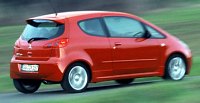 The CZT
is a competent performer on highway. As long as you keep its engine
revving at above 3000 rpm, it has abundance of punch. Of course, it is
no match with the 182hp Renault Clio, which is in another league, but
CZT is faster than regular "warm hatches" like Ford Fiesta ST and
Peugeot 206 GTi. Because of the stronger torque, it pulls stronger in
mid-range, requiring no super-short gear ratios like Fiesta ST. That
means the engine always rev calmer, benefiting cruising refinement. The CZT
is a competent performer on highway. As long as you keep its engine
revving at above 3000 rpm, it has abundance of punch. Of course, it is
no match with the 182hp Renault Clio, which is in another league, but
CZT is faster than regular "warm hatches" like Ford Fiesta ST and
Peugeot 206 GTi. Because of the stronger torque, it pulls stronger in
mid-range, requiring no super-short gear ratios like Fiesta ST. That
means the engine always rev calmer, benefiting cruising refinement.
There is no discernible turbo lag, but the turbo engine still has a
number of drawbacks compare with a 2-litre normally aspirated engine,
such as its weaker bottom-end output, slower throttle response and a
less-than-eager engine note. That's why the CZT is more lovely on the
highway than on twisty mountain roads.
 The
chassis has similar problems - it is user friendly rather than
inspiring, competent in most circumstances instead of maximum attack.
There is no big flaws in any area - it grips well, stop well and feels
light and agile. Inevitably, its tall body (still in excess of 1.5
meters !) rolls more than traditional hot hatches in corner, but not
indecent by today's downgrading standard. However, if you push it
really hard, you will discover a hint of torque steer at the front
wheels, by then ESP will cut engine power to correct things. The same
goes for oversteering, which is carefully watched by the ESP. The CZT
is therefore safe and easy to drive. It just lacks the sharpness of
Mini Cooper S and the wildness of Renault Sport Clio. Most crucial, it
is not as involving to drive as a hot hatch should. A more inspiring
steering feel could compensate, but unfortunately it feels no different
from the standard Colt. The
chassis has similar problems - it is user friendly rather than
inspiring, competent in most circumstances instead of maximum attack.
There is no big flaws in any area - it grips well, stop well and feels
light and agile. Inevitably, its tall body (still in excess of 1.5
meters !) rolls more than traditional hot hatches in corner, but not
indecent by today's downgrading standard. However, if you push it
really hard, you will discover a hint of torque steer at the front
wheels, by then ESP will cut engine power to correct things. The same
goes for oversteering, which is carefully watched by the ESP. The CZT
is therefore safe and easy to drive. It just lacks the sharpness of
Mini Cooper S and the wildness of Renault Sport Clio. Most crucial, it
is not as involving to drive as a hot hatch should. A more inspiring
steering feel could compensate, but unfortunately it feels no different
from the standard Colt.
However, Mitsubishi seems content of positioning it against other "warm
hatches" instead of the full-blooded Mini Cooper S and Renault Sport
Clio. In this way, the £13,000 price, the performance and user
friendliness are highly competitive. It just lost a chance to storm the
hot hatch world like what it did with Lancer Evo in higher segment.
|
| The
above report was last updated on 15 Feb
2005. All Rights Reserved. |
Colt CZC
|
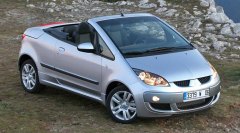 2006
is the year of retractable metal roofs. In this year we see the debut
of Volvo C70, Opel Astra TwinTop, Volkswagen Eos, Ford Focus CC and
this one, Mitsubishi Colt CZC. The Mitsubishi open-top supermini is
engineered and built by Pininfarina (the same as Ford Focus CC and
Volvo C70). It joins Peugeot 206CC and Nissan Micra C+C as the smallest
“coupe-cabriolets” in the market. 2006
is the year of retractable metal roofs. In this year we see the debut
of Volvo C70, Opel Astra TwinTop, Volkswagen Eos, Ford Focus CC and
this one, Mitsubishi Colt CZC. The Mitsubishi open-top supermini is
engineered and built by Pininfarina (the same as Ford Focus CC and
Volvo C70). It joins Peugeot 206CC and Nissan Micra C+C as the smallest
“coupe-cabriolets” in the market.
To distinguish from its rivals, Colt CZC has sportier suspension setup
and the most powerful engine in the class – the 150 horsepower
1.5-litre 16V turbo from CZT. The combination of strong turbocharged
torque and superb 5-speed manual gearbox allows the little
coupe-cabriolet to sprint from zero to 60 mph in 7.9 seconds. For your
record, although the roof conversion added 130 kg, its overall kerb
weight of 1125 kg is still the lightest of the class. Big power and low
weight, no wonder CZC turbo provides near hot hatch performance.
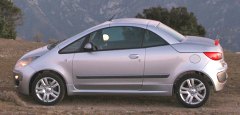 Handling
is another matter. CZC’s chassis is not as rigid as Nissan Micra C+C.
If you push it on demanding B-roads like you were driving a hot hatch,
you will find plenty of shake and vibration. Its ride quality also
suffers on rough surfaces due to the stiffer suspension setup (to deal
with the extra weight). On the plus side, it provides the most faithful
steering in the class, being well-weighted, accurate and quite
communicative. While it is not an alternative to hot hatches, it
delivers more driving fun than Micra C+C and Peugeot 206CC. Handling
is another matter. CZC’s chassis is not as rigid as Nissan Micra C+C.
If you push it on demanding B-roads like you were driving a hot hatch,
you will find plenty of shake and vibration. Its ride quality also
suffers on rough surfaces due to the stiffer suspension setup (to deal
with the extra weight). On the plus side, it provides the most faithful
steering in the class, being well-weighted, accurate and quite
communicative. While it is not an alternative to hot hatches, it
delivers more driving fun than Micra C+C and Peugeot 206CC.
Colt CZC is claimed to be a 2+2, but in fact the rear seats are too
small to carry any people. Luckily, the front seats have no problem to
carry big guys. Praise must be given that Mitsubishi avoided the fast
and low windscreen found in 206CC and Micra C+C, leaving plenty of
headroom and good forward visibility. The metal roof is also well
engineered by Pininfarina. It opens and closes in 22 seconds. When it
is stored in the boot, there is still 190 litres of luggage space.
This expand to a remarkable 460 litres when the roof is up.
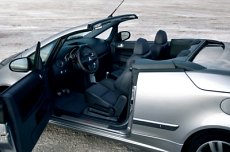 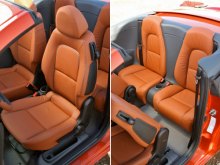 |
| The
above report was last updated on 20 Apr
2006. All Rights Reserved. |
|
|